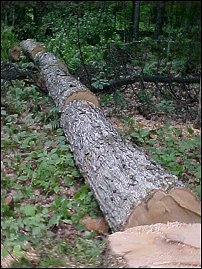
|
|
||||
|
Getting the Most Return From Your Timber Sale
|
|||||||
 |
|
||||||
| Protect
Yourself and Your Property With a Timber Sales Contract |
Professional Foresters Protect the Landowner and the Forest by Negotiating a Timber Sales Contract That:
|
||||||
| Every timber sale, no matter how small, should have a written timber sales contract which details what the seller and the buyer have agreed upon. The process of negotiating the contract provides an opportunity for the seller and the buyer to discuss how the harvesting operation will occur and to identify and obtain clarification and agreement on areas of concern. This will substantially reduce the possibility of misunderstandings and disagreements and provide |
both you, as the seller, and the buyer with legal protection as agreed to by the terms and agreements of the contract. There are many sample timber sale contracts available, and many timber buyers have a "standard" contract. You should, however, work with your forester to ensure that the contract addresses your concerns, meets your needs, and protects your rights. You may wish to have the document reviewed by an attorney. |
|
|||||
|
|
Monitor the Harvest The final step of a successful timber sale is to monitor the harvest. Frequent visits should be made to ensure that the harvest is proceeding properly, according to the terms of the contract, and to discuss questions that might arise. Again, because many of the activities associated with timber harvesting are unfamiliar to most woodland owners, monitoring the harvest is often best done with the assistance of a professional forester. Aspects of a timber harvest routinely monitored include property access, cutting of unmarked trees, damage to residual (unmarked) trees, road and landing locations, construction, and rehabilitation, and the use of best management practices (BMPs) to protect soil and water resources.
|
||||||
![]() TOP
Press arrow to return to
the top of this page.
TOP
Press arrow to return to
the top of this page.

This website is maintained
by Bill Cook, Michigan State University Extension
Forester in the Upper Peninsula. Comments, questions,
and suggestions are gratefully accepted.
Last update of this page
was
12 February, 2014
This site is hosted by School of Forest Resources and Environmental Science at Michigan Technological University.